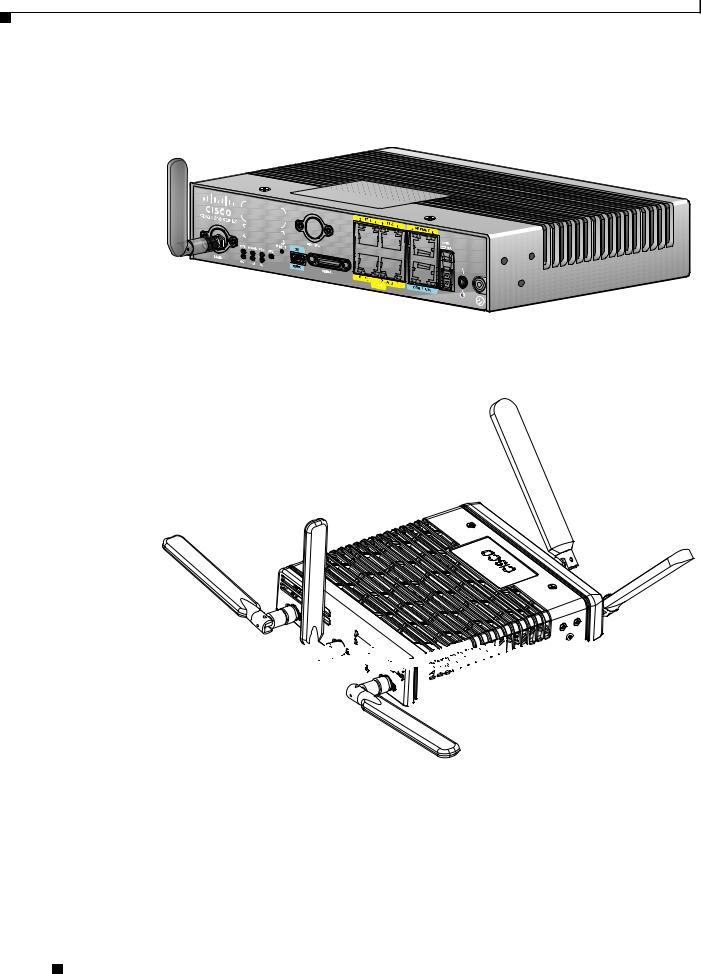Cisco Systems C819GUK9, C819HG4GVK9 User Manual

Cisco 819 Series Integrated Services
Routers Software Configuration Guide
Americas Headquarters
Cisco Systems, Inc. 170 West Tasman Drive
San Jose, CA 95134-1706 USA http://www.cisco.com Tel: 408 526-4000
800 553-NETS (6387) Fax: 408 527-0883
Text Part Number: OL-23590-02
September 2, 2013
THE SPECIFICATIONS AND INFORMATION REGARDING THE PRODUCTS IN THIS MANUAL ARE SUBJECT TO CHANGE WITHOUT NOTICE. ALL STATEMENTS, INFORMATION, AND RECOMMENDATIONS IN THIS MANUAL ARE BELIEVED TO BE ACCURATE BUT ARE PRESENTED WITHOUT WARRANTY OF ANY KIND, EXPRESS OR IMPLIED. USERS MUST TAKE FULL RESPONSIBILITY FOR THEIR APPLICATION OF ANY PRODUCTS.
THE SOFTWARE LICENSE AND LIMITED WARRANTY FOR THE ACCOMPANYING PRODUCT ARE SET FORTH IN THE INFORMATION PACKET THAT SHIPPED WITH THE PRODUCT AND ARE INCORPORATED HEREIN BY THIS REFERENCE. IF YOU ARE UNABLE TO LOCATE THE SOFTWARE LICENSE OR LIMITED WARRANTY, CONTACT YOUR CISCO REPRESENTATIVE FOR A COPY.
The Cisco implementation of TCP header compression is an adaptation of a program developed by the University of California, Berkeley (UCB) as part of UCB’s public domain version of the UNIX operating system. All rights reserved. Copyright © 1981, Regents of the University of California.
NOTWITHSTANDING ANY OTHER WARRANTY HEREIN, ALL DOCUMENT FILES AND SOFTWARE OF THESE SUPPLIERS ARE PROVIDED “AS IS” WITH ALL FAULTS. CISCO AND THE ABOVE-NAMED SUPPLIERS DISCLAIM ALL WARRANTIES, EXPRESSED OR IMPLIED, INCLUDING, WITHOUT LIMITATION, THOSE OF MERCHANTABILITY, FITNESS FOR A PARTICULAR PURPOSE AND NONINFRINGEMENT OR ARISING FROM A COURSE OF DEALING, USAGE, OR TRADE PRACTICE.
IN NO EVENT SHALL CISCO OR ITS SUPPLIERS BE LIABLE FOR ANY INDIRECT, SPECIAL, CONSEQUENTIAL, OR INCIDENTAL DAMAGES, INCLUDING, WITHOUT LIMITATION, LOST PROFITS OR LOSS OR DAMAGE TO DATA ARISING OUT OF THE USE OR INABILITY TO USE THIS MANUAL, EVEN IF CISCO OR ITS SUPPLIERS HAVE BEEN ADVISED OF THE POSSIBILITY OF SUCH DAMAGES.
Cisco and the Cisco logo are trademarks or registered trademarks of Cisco and/or its affiliates in the U.S. and other countries. To view a list of Cisco trademarks, go to this URL: www.cisco.com/go/trademarks. Third-party trademarks mentioned are the property of their respective owners. The use of the word partner does not imply a partnership relationship between Cisco and any other company. (1110R)
Any Internet Protocol (IP) addresses and phone numbers used in this document are not intended to be actual addresses and phone numbers. Any examples, command display output, network topology diagrams, and other figures included in the document are shown for illustrative purposes only. Any use of actual IP addresses or phone numbers in illustrative content is unintentional and coincidental.
Cisco 819 Series Integrated Services Routers Software Configuration Guide
© 2013 Cisco Systems, Inc. All rights reserved.

|
|
|
|
|
|
|
|
|
C O N T E N T S |
|||
|
|
Product Overview |
|
|
|
|
|
|
|
|
||
C H A P T E R |
1 |
1-1 |
|
|
|
|
|
|
|
|||
|
|
|
General Description |
1-1 |
|
|
|
|
|
|
||
|
|
|
SKU Information |
1-3 |
|
|
|
|
|
|
|
|
|
|
|
New Features |
1-3 |
|
|
|
|
|
|
|
|
|
|
|
3G Features |
1-3 |
|
|
|
|
|
|
|
|
|
|
|
WLAN Features |
1-4 |
|
|
|
|
|
|
||
|
|
|
4G LTE Features |
1-4 |
|
|
|
|
|
|
||
|
|
|
Platform Features |
1-4 |
|
|
|
|
|
|
||
|
|
|
Security Features |
1-4 |
|
|
|
|
|
|
||
|
|
Wireless Device Overview |
|
|
|
|
|
|
||||
C H A P T E R |
2 |
2-1 |
|
|
|
|
|
|||||
|
|
|
ScanSafe |
2-1 |
|
|
|
|
|
|
|
|
|
|
|
TFTP support with Ethernet WAN interface 2-2 |
|||||||||
|
|
|
LEDs 2-2 |
|
|
|
|
|
|
|
|
|
|
|
Wireless Local Area Network |
|
|
|
|
|
|||||
C H A P T E R |
3 |
3-1 |
|
|
|
|
||||||
|
|
|
WLAN Features |
3-1 |
|
|
|
|
|
|
|
|
|
|
|
Dual-Radio 3-1 |
|
|
|
|
|
|
|
||
|
|
|
Images Supported |
3-2 |
|
|
|
|
|
|||
|
|
|
CleanAir Technology |
3-2 |
|
|
|
|
|
|||
|
|
|
Dynamic Frequency Selection |
3-2 |
|
|
|
|||||
|
|
|
LEDs |
3-2 |
|
|
|
|
|
|
|
|
|
|
|
3-3 |
|
|
|
|
|
|
|
|
|
|
|
4G LTE Wireless WAN |
|
|
|
|
|
|
|
|||
C H A P T E R |
4 |
4-1 |
|
|
|
|
|
|
||||
|
|
Basic Router Configuration |
|
|
|
|
|
|
||||
C H A P T E R |
5 |
5-1 |
|
|
|
|
|
|||||
|
|
|
Interface Ports |
5-2 |
|
|
|
|
|
|
|
|
|
|
|
Default Configuration |
5-2 |
|
|
|
|
|
|
||
|
|
|
Information Needed for Configuration 5-3 |
|||||||||
|
|
|
Configuring Command-Line Access |
5-5 |
|
|
|
|||||
|
|
|
Example 5-7 |
|
|
|
|
|
|
|||
|
|
|
Configuring Global Parameters |
5-8 |
|
|
|
|
||||
|
|
|
|
|
|
|
Cisco 819 Series Integrated Services Routers Software Configuration Guide |
|
|
|
||
|
|
|
|
|
|
|
|
|||||
|
|
|
|
|
|
|
|
|
|
|
|
|
|
OL-23590-02 |
|
|
|
|
|
|
|
|
1 |
|
|
|
|
|
|
|
|
|
|
|
|
|||

Contents
Configuring WAN Interfaces |
5-9 |
|
Configuring a Gigabit Ethernet WAN Interface |
5-9 |
|
Configuring the Cellular Wireless WAN Interface |
5-10 |
|
Prerequisites for Configuring the 3G Wireless Interface 5-11 |
||
Restrictions for Configuring the Cellular Wireless Interface 5-11 |
||
Data Account Provisioning 5-12 |
|
|
Configuring a Cellular Interface 5-16 |
|
|
Configuring DDR |
5-17 |
|
|
Examples for Configuring Cellular Wireless Interfaces |
5-20 |
|
|||||||
|
Configuring Dual SIM for Cellular Networks |
5-22 |
|
|
|
|
||||
|
Configuring Router for Image and Config Recovery Using Push Button |
5-23 |
||||||||
|
Output When Button Is Not Pushed: Example |
5-24 |
|
|
||||||
|
Output When Button Is Pushed: Example |
5-24 |
|
|
|
|||||
|
Push Button in WLAN AP |
5-25 |
|
|
|
|
|
|||
|
Configuring the Fast Ethernet LAN Interfaces |
5-25 |
|
|
|
|||||
|
Configuring a Loopback Interface |
5-25 |
|
|
|
|
|
|||
|
Example |
5-26 |
|
|
|
|
|
|
|
|
|
Verifying Configuration |
5-26 |
|
|
|
|
|
|||
|
Configuring Static Routes 5-27 |
|
|
|
|
|
|
|||
|
Example |
5-28 |
|
|
|
|
|
|
|
|
|
Verifying Configuration |
5-28 |
|
|
|
|
|
|
||
|
Configuring Dynamic Routes |
5-28 |
|
|
|
|
|
|
||
|
Configuring Routing Information Protocol 5-29 |
|
|
|
|
|||||
|
Example |
5-30 |
|
|
|
|
|
|
|
|
|
Verifying Configuration |
5-30 |
|
|
|
|
|
|||
|
Configuring Enhanced Interior Gateway Routing Protocol |
5-30 |
|
|||||||
|
Example |
5-31 |
|
|
|
|
|
|
|
|
|
Verifying Configuration |
5-31 |
|
|
|
|
|
|||
|
Configuring Backup Data Lines and Remote Management |
|
|
|||||||
C H A P T E R 6 |
6-1 |
|
||||||||
|
Configuring Backup Interfaces |
6-1 |
|
|
|
|
|
|||
|
Configuring Cellular Dial-on-Demand Routing Backup |
6-3 |
|
|
|
|||||
|
Configuring DDR Backup Using Dialer Watch |
6-3 |
|
|
|
|
||||
|
Configuring DDR Backup Using Floating Static Route |
6-5 |
|
|
||||||
|
Cellular Wireless Modem as Backup with NAT and IPsec Configuration |
6-5 |
||||||||
|
Configuring Dial Backup and Remote Management Through the Console Port |
6-8 |
||||||||
|
Example |
6-13 |
|
|
|
|
|
|
|
|
Cisco 819 Series Integrated Services Routers Software Configuration Guide
2 |
OL-23590-02 |
|
|

Contents
C H A P T E R |
7 |
Environmental and Power Management |
7-1 |
|
|
||||
|
|
Cisco EnergyWise Support |
7-2 |
|
|
|
|
|
|
|
|
Configuring the Serial Interface |
|
|
|
|
|
||
C H A P T E R |
8 |
8-1 |
|
|
|
|
|||
|
|
Legacy Protocol Transport |
8-2 |
|
|
|
|
|
|
|
|
Configuring Serial Interfaces |
8-2 |
|
|
|
|
||
|
|
Information About Configuring Serial Interfaces |
8-3 |
||||||
|
|
Cisco HDLC Encapsulation |
8-3 |
|
|
|
|
||
|
|
PPP Encapsulation |
8-3 |
|
|
|
|
|
|
|
|
Multilink PPP |
8-4 |
|
|
|
|
|
|
|
|
Keepalive Timer |
8-4 |
|
|
|
|
|
|
|
|
Frame Relay Encapsulation |
8-5 |
|
|
|
|
||
|
|
LMI on Frame Relay Interfaces |
8-6 |
|
|
||||
|
|
How to Configure Serial Interfaces |
8-6 |
|
|
|
|||
|
|
Configuring a Synchronous Serial Interface |
8-6 |
||||||
|
|
Specifying a Synchronous Serial Interface 8-7 |
|||||||
|
|
Specifying Synchronous Serial Encapsulation 8-7 |
|||||||
|
|
Configuring PPP 8-8 |
|
|
|
|
|
||
|
|
Configuring Half-Duplex and Bisync for Synchronous Serial Port Adapters on Cisco 819 |
|||||||
|
|
ISRs 8-8 |
|
|
|
|
|
|
|
|
|
Configuring Compression of HDLC Data |
8-9 |
||||||
|
|
Using the NRZI Line-Coding Format |
8-9 |
||||||
|
|
Enabling the Internal Clock |
8-10 |
|
|
||||
|
|
Inverting the Transmit Clock Signal |
8-10 |
||||||
|
|
Setting Transmit Delay |
8-11 |
|
|
|
|||
|
|
Configuring DTR Signal Pulsing |
8-11 |
|
|
||||
|
|
Ignoring DCD and Monitoring DSR as Line Up/Down Indicator 8-11 |
|||||
|
|
Specifying the Serial Network Interface Module Timing 8-12 |
|||||
|
|
Configuring Low-Speed Serial Interfaces |
8-14 |
|
|
|
|
|
|
Understanding Half-Duplex DTE and DCE State Machines |
8-14 |
|
|
|
|
|
|
Changing Between Synchronous and Asynchronous Modes |
8-18 |
|
|
|
|
|
|
Configuration Examples 8-19 |
|
|
|
|
|
|
|
Interface Enablement Configuration: Examples 8-19 |
|
|
|
|
|
|
|
Low-Speed Serial Interface: Examples 8-20 |
|
|
|
|
|
|
|
Synchronous or Asynchronous Mode: Examples 8-20 |
|
|
|
|
|
|
|
Half-Duplex Timers: Example 8-20 |
|
|
|
|
|
|
Configuring Security Features 9-1 |
|
|
|
|
|
|
C H A P T E R 9 |
|
|
|
|
|
||
|
|
Authentication, Authorization, and Accounting |
9-1 |
|
|
|
|
|
|
Cisco 819 Series Integrated Services Routers Software Configuration Guide |
|
|
|
||
|
|
|
|||||
|
|
|
|
|
|
|
|
|
OL-23590-02 |
|
|
|
|
3 |
|
|
|
|
|
|
|
||

Contents
Configuring AutoSecure |
9-2 |
|
|
|
|
Configuring Access Lists |
9-2 |
|
|
|
|
Access Groups |
9-3 |
|
|
|
|
Configuring Cisco IOS Firewall |
9-3 |
|
|
||
Configuring Cisco IOS IPS |
9-4 |
|
|
||
URL Filtering 9-4 |
|
|
|
|
|
Configuring VPN 9-4 |
|
|
|
|
|
Remote Access VPN |
9-5 |
|
|
||
Site-to-Site VPN |
9-6 |
|
|
|
|
Configuration Examples |
9-7 |
|
|
||
Configure a VPN over an IPSec Tunnel |
9-7 |
|
|||
Configure the IKE Policy 9-7 |
|
|
|||
Configure Group Policy Information |
9-9 |
|
|||
Apply Mode Configuration to the Crypto Map |
9-10 |
||||
Enable Policy Lookup |
9-11 |
|
|
||
Configure IPSec Transforms and Protocols 9-12 |
|||||
Configure the IPSec Crypto Method and Parameters 9-12 |
|||||
Apply the Crypto Map to the Physical Interface |
9-14 |
||||
Where to Go Next |
9-14 |
|
|
||
|
|
|
|
Create a Cisco Easy VPN Remote Configuration 9-15 |
|||||
|
|
|
|
Configuration Example |
9-16 |
|
|
||
|
|
|
|
Configure a Site-to-Site GRE Tunnel 9-17 |
|||||
|
|
|
|
Configuration Example |
9-19 |
|
|
||
|
Configuring the Ethernet Switches 10-1 |
||||||||
C H A P T E R 10 |
|||||||||
|
|
|
|
Switch Port Numbering and Naming |
10-1 |
|
|||
|
|
|
|
Restrictions for the FE Switch |
10-1 |
|
|
||
|
|
|
|
Information About Ethernet Switches |
10-2 |
|
|||
|
|
|
|
VLANs and VLAN Trunk Protocol |
10-2 |
|
|||
|
|
|
|
Layer 2 Ethernet Switching |
10-2 |
|
|
||
|
|
|
|
802.1x Authentication |
10-2 |
|
|
||
|
|
|
|
Spanning Tree Protocol |
10-2 |
|
|
||
|
|
|
|
Cisco Discovery Protocol |
10-2 |
|
|
||
|
|
|
|
Switched Port Analyzer |
10-3 |
|
|
||
|
|
|
|
IGMP Snooping |
10-3 |
|
|
|
|
|
|
|
|
Storm Control 10-3 |
|
|
|
|
|
|
|
|
|
Fallback Bridging |
10-3 |
|
|
|
|
|
|
|
|
Overview of SNMP MIBs |
10-3 |
|
|
|
|
|
|
|
|
BRIDGE-MIB for Layer 2 Ethernet Switching 10-4 |
|||||
|
|
|
Cisco 819 Series Integrated Services Routers Software Configuration Guide |
||||||
|
|
|
|||||||
|
|
|
|
|
|
|
|
|
|
|
4 |
|
|
|
|
|
|
OL-23590-02 |
|
|
|
|
|
|
|
|
|
||

Contents
|
|
|
MAC Address Notification |
10-5 |
|
|
|
|
|
|
||||
|
|
|
How to Configure Ethernet Switches |
10-6 |
|
|
|
|
|
|||||
|
|
|
Configuring VLANs |
10-6 |
|
|
|
|
|
|
|
|
||
|
|
|
|
VLANs on the FE Ports |
10-6 |
|
|
|
|
|
|
|||
|
|
|
|
VLANs on the GE Port |
10-7 |
|
|
|
|
|
|
|||
|
|
|
Configuring Layer 2 Interfaces |
10-7 |
|
|
|
|
|
|
||||
|
|
|
Configuring 802.1x Authentication 10-8 |
|
|
|
|
|||||||
|
|
|
Configuring Spanning Tree Protocol |
10-8 |
|
|
|
|
||||||
|
|
|
Configuring MAC Table Manipulation |
|
10-9 |
|
|
|
|
|||||
|
|
|
Configuring Cisco Discovery Protocol |
|
10-9 |
|
|
|
|
|||||
|
|
|
Configuring the Switched Port Analyzer |
10-10 |
|
|
|
|||||||
|
|
|
Configuring IP Multicast Layer 3 Switching |
10-10 |
|
|
|
|||||||
|
|
|
Configuring IGMP Snooping |
10-10 |
|
|
|
|
|
|
||||
|
|
|
Configuring Per-Port Storm Control |
10-10 |
|
|
|
|
||||||
|
|
|
Configuring Fallback Bridging |
|
10-11 |
|
|
|
|
|
|
|||
|
|
|
Managing the Switch |
10-12 |
|
|
|
|
|
|
|
|||
|
|
Configuring PPP over Ethernet with NAT |
|
|
|
|
|
|||||||
C H A P T E R |
11 |
11-1 |
|
|
|
|
||||||||
|
|
|
PPPoE |
11-2 |
|
|
|
|
|
|
|
|
|
|
|
|
|
NAT |
11-2 |
|
|
|
|
|
|
|
|
|
|
|
|
|
Configuration Tasks |
11-2 |
|
|
|
|
|
|
|
|
||
|
|
|
Configure the Virtual Private Dialup Network Group Number 11-2 |
|||||||||||
|
|
|
Configure the Fast Ethernet WAN Interfaces |
11-3 |
|
|
|
|||||||
|
|
|
Configure the Dialer Interface |
11-4 |
|
|
|
|
|
|
||||
|
|
|
Configure Network Address Translation |
11-6 |
|
|
|
|||||||
|
|
|
Configuration Example |
11-9 |
|
|
|
|
|
|
|
|
||
|
|
|
Verifying Your Configuration |
11-11 |
|
|
|
|
|
|
||||
|
|
Configuring a LAN with DHCP and VLANs |
|
|
|
|
|
|
||||||
C H A P T E R |
12 |
|
12-1 |
|
|
|
|
|||||||
|
|
|
DHCP |
12-1 |
|
|
|
|
|
|
|
|
|
|
|
|
|
VLANs |
12-2 |
|
|
|
|
|
|
|
|
|
|
|
|
|
Configuration Tasks |
12-2 |
|
|
|
|
|
|
|
|
||
|
|
|
Configure DHCP |
12-2 |
|
|
|
|
|
|
|
|
||
|
|
|
|
Configuration Example |
12-4 |
|
|
|
|
|
|
|||
|
|
|
|
Verify Your DHCP Configuration |
12-4 |
|
|
|
|
|||||
|
|
|
Configure VLANs |
12-5 |
|
|
|
|
|
|
|
|
||
|
|
|
Assign a Switch Port to a VLAN |
12-6 |
|
|
|
|
|
|||||
|
|
|
Verify Your VLAN Configuration |
12-7 |
|
|
|
|
|
|||||
|
|
|
|
|
|
Cisco 819 Series Integrated Services Routers Software Configuration Guide |
|
|
|
|||||
|
|
|
|
|
|
|
||||||||
|
|
|
|
|
|
|
|
|
|
|
|
|
|
|
|
OL-23590-02 |
|
|
|
|
|
|
|
|
|
|
5 |
|
|
|
|
|
|
|
|
|
|
|
|
|
|
|||

Contents
C H A P T E R |
13 |
Configuring a VPN Using Easy VPN and an IPSec Tunnel |
13-1 |
|
||||||||||||
|
|
|
|
|
Cisco Easy VPN |
13-2 |
|
|
|
|
|
|
|
|||
|
|
|
|
|
Configuration Tasks |
13-3 |
|
|
|
|
|
|
||||
|
|
|
|
|
Configure the IKE Policy |
13-3 |
|
|
|
|
|
|||||
|
|
|
|
|
Configure Group Policy Information 13-5 |
|
|
|
|
|||||||
|
|
|
|
|
Apply Mode Configuration to the Crypto Map |
13-6 |
|
|
||||||||
|
|
|
|
|
Enable Policy Lookup |
13-7 |
|
|
|
|
|
|||||
|
|
|
|
|
Configure IPSec Transforms and Protocols |
13-8 |
|
|
||||||||
|
|
|
|
|
Configure the IPSec Crypto Method and Parameters |
13-8 |
|
|||||||||
|
|
|
|
|
Apply the Crypto Map to the Physical Interface |
13-10 |
|
|
||||||||
|
|
|
|
|
Create an Easy VPN Remote Configuration |
13-10 |
|
|
||||||||
|
|
|
|
|
|
Verifying Your Easy VPN Configuration |
13-12 |
|
|
|||||||
|
|
|
|
|
Configuration Example |
13-12 |
|
|
|
|
|
|
||||
|
|
|
Cisco IOS Software Basic Skills |
|
|
|
|
|
||||||||
A P P E N D I X |
|
A |
A-1 |
|
|
|
|
|||||||||
|
|
|
|
|
Configuring the Router from a PC |
A-1 |
|
|
|
|
||||||
|
|
|
|
|
Understanding Command Modes |
A-2 |
|
|
|
|
||||||
|
|
|
|
|
Getting Help |
A-4 |
|
|
|
|
|
|
|
|
||
|
|
|
|
|
Enable Secret Passwords and Enable Passwords |
|
A-5 |
|
|
|||||||
|
|
|
|
|
Entering Global Configuration Mode A-5 |
|
|
|
|
|||||||
|
|
|
|
|
Using Commands |
A-6 |
|
|
|
|
|
|
|
|||
|
|
|
|
|
Abbreviating Commands |
A-6 |
|
|
|
|
|
|||||
|
|
|
|
|
Undoing Commands |
A-6 |
|
|
|
|
|
|
||||
|
|
|
|
|
Command-Line Error Messages |
A-6 |
|
|
|
|
||||||
|
|
|
|
|
Saving Configuration Changes |
A-7 |
|
|
|
|
||||||
|
|
|
|
|
Summary |
A-7 |
|
|
|
|
|
|
|
|
|
|
|
|
|
|
|
Where to Go Next |
A-7 |
|
|
|
|
|
|
|
|||
|
|
|
Concepts |
|
|
|
|
|
|
|
|
|
|
|||
A P P E N D I X |
|
B |
B-1 |
|
|
|
|
|
|
|
|
|
||||
|
|
|
|
|
Network Protocols |
B-1 |
|
|
|
|
|
|
|
|||
|
|
|
|
|
IP |
B-1 |
|
|
|
|
|
|
|
|
|
|
|
|
|
|
|
Routing Protocol Options |
B-2 |
|
|
|
|
|
|
||||
|
|
|
|
|
RIP |
|
B-2 |
|
|
|
|
|
|
|
|
|
|
|
|
|
|
Enhanced IGRP |
B-3 |
|
|
|
|
|
|
||||
|
|
|
|
|
PPP Authentication Protocols |
B-3 |
|
|
|
|
|
|||||
|
|
|
|
|
PAP |
|
B-3 |
|
|
|
|
|
|
|
|
|
|
|
|
|
|
CHAP |
B-4 |
|
|
|
|
|
|
|
|
||
|
|
|
|
Cisco 819 Series Integrated Services Routers Software Configuration Guide |
|
|
|
|
||||||||
|
|
|
|
|
|
|
|
|||||||||
|
|
|
|
|
|
|
|
|
|
|
|
|
|
|
|
|
|
6 |
|
|
|
|
|
|
|
|
|
|
|
|
|
OL-23590-02 |
|
|
|
|
|
|
|
|
|
|
|
|
|
|
|
|
||

Contents
|
|
|
TACACS+ |
B-4 |
|
|
|
|
|
|
|
|
|
|
|
Ethernet B-4 |
|
|
|
|
|
|
|
||
|
|
|
Dial Backup |
B-5 |
|
|
|
|
|
|
|
|
|
|
|
|
Backup Interface |
B-5 |
|
|
|
|
|
||
|
|
|
|
Floating Static Routes |
B-5 |
|
|
|
|
|||
|
|
|
|
Dialer Watch |
B-5 |
|
|
|
|
|
|
|
|
|
|
NAT |
B-6 |
|
|
|
|
|
|
|
|
|
|
|
Easy IP (Phase 1) |
B-6 |
|
|
|
|
|
|
||
|
|
|
Easy IP (Phase 2) |
B-7 |
|
|
|
|
|
|
||
|
|
|
QoS |
B-7 |
|
|
|
|
|
|
|
|
|
|
|
|
IP Precedence |
B-8 |
|
|
|
|
|
||
|
|
|
|
PPP Fragmentation and Interleaving |
B-8 |
|||||||
|
|
|
|
CBWFQ |
B-8 |
|
|
|
|
|
|
|
|
|
|
|
RSVP |
B-8 |
|
|
|
|
|
|
|
|
|
|
|
Low Latency Queuing |
B-9 |
|
|
|
|
|||
|
|
|
Access Lists |
B-9 |
|
|
|
|
|
|
|
|
|
|
ROM Monitor |
|
|
|
|
|
|
|
|
||
A P P E N D I X |
C |
C-1 |
|
|
|
|
|
|
|
|||
|
|
|
Entering the ROM Monitor |
C-1 |
|
|
|
|
||||
|
|
|
ROM Monitor Commands |
C-2 |
|
|
|
|
||||
|
|
|
Command Descriptions |
C-3 |
|
|
|
|
||||
|
|
|
Disaster Recovery with TFTP Download |
C-3 |
||||||||
|
|
|
|
TFTP Download Command Variables |
C-4 |
|||||||
|
|
|
|
Required Variables |
C-4 |
|
|
|
|
|||
|
|
|
|
Optional Variables |
C-5 |
|
|
|
|
|||
|
|
|
|
Using the TFTP Download Command |
C-5 |
|||||||
|
|
|
|
Examples |
C-6 |
|
|
|
|
|
||
|
|
|
Configuration Register |
C-10 |
|
|
|
|
||||
|
|
|
|
Changing the Configuration Register Manually C-11 |
||||||||
|
|
|
|
Changing the Configuration Register Using Prompts C-11 |
||||||||
|
|
|
Console Download |
C-12 |
|
|
|
|
|
|||
|
|
|
|
Command Description |
C-12 |
|
|
|
|
|||
|
|
|
|
Error Reporting |
C-13 |
|
|
|
|
|
||
|
|
|
Debug Commands |
C-13 |
|
|
|
|
|
|||
|
|
|
Exiting the ROM Monitor |
C-14 |
|
|
|
|
||||
|
|
Common Port Assignments |
|
|
|
|
|
|||||
A P P E N D I X |
D |
D-1 |
|
|
|
|
||||||
|
|
|
|
|
|
|
|
Cisco 819 Series Integrated Services Routers Software Configuration Guide |
|
|
|
|
|
|
|
|
|
|
|
|
|
||||
|
|
|
|
|
|
|
|
|
|
|
|
|
|
OL-23590-02 |
|
|
|
|
|
|
|
|
|
7 |
|
|
|
|
|
|
|
|
|
|
|
|
||

Contents
Cisco 819 Series Integrated Services Routers Software Configuration Guide
8 |
OL-23590-02 |
|
|

C H A P T E R 1
Product Overview
This chapter provides an overview of the features available for the Cisco 819 Integrated Services Routers (ISRs) and contains the following sections:
•General Description, page 1-1
•SKU Information, page 1-3
•New Features, page 1-3
General Description
The Cisco 819 ISRs provide Internet, VPN, data, and backup capability to corporate teleworkers and remote and small offices of fewer than 20 users. These routers are capable of bridging and multiprotocol routing between LAN and WAN ports and provide advanced features such as antivirus protection.
The Cisco 819 ISRs are fixed-configuration data routers that provide four 10/100 Fast Ethernet (FE), 1 Gigabit Ethernet (GE), and WAN connections over Serial and Cellular (3G) interface.
The Cisco 819HGW and Cisco 819HWD ISRs support WiFi radios (AP802H-AGN). A Wireless Local Area Network (WLAN) implements a flexible data communication system frequently augmenting rather than replacing a wired LAN within a building or campus. WLANs use radio frequency to transmit and receive data over the air, minimizing the need for wired connections.
The Cisco 819HG-4G and Cisco 819G-4G support multimode 4G LTE and have embedded Sierra Wireless multimode modem.
Note Cisco 819 ISR is used to refer to Cisco 819G , Cisco 819HG, Cisco 819H, Cisco 819HWD, Cisco 819HGW, Cisco 819HG-4G, and Cisco 819G-4G ISRs unless specifically called out otherwise.
Cisco 819 Series Integrated Services Routers Software Configuration Guide
|
OL-23590-02 |
1-1 |
|
|
|

Chapter 1 Product Overview
General Description
Figure 1-1 shows the Cisco 819HG ISR.
Figure 1-1 Cisco 819HG Integrated Services Router
283010
Figure 1-2 shows the Cisco 819HGW ISR.
Figure 1-2 Cisco 819HGW Integrated Services Router



























































 285479
285479
Cisco 819 Series Integrated Services Routers Software Configuration Guide
1-2 |
OL-23590-02 |
|
|

Chapter 1 Product Overview
SKU Information
SKU Information
For the complete list of SKUs available in Cisco 819 ISRs, see SKU Information.
New Features
This section lists the software, platform, and security features supported by the Cisco 819 ISRs.
•3G Features, page 1-3
•WLAN Features, page 1-4
•4G LTE Features, page 1-4
•Platform Features, page 1-4
•Security Features, page 1-4
Note The WAAS Express feature is not supported. This feature will be supported for 3G and 4G interfaces with later IOS releases.
3G Features
•Modem control and management
•Asynchronous transport (AT) command set
•Wireless Host Interface Protocol (WHIP)
•Control and Status (CNS) for out-of-band modem control and status
•Diagnostic Monitor (DM) logging
•Account provisioning
•Modem firmware upgrade
•SIM locking and unlocking
•MEP unlocking
•OMA-DM activation
•Dual SIM card slots
•Link persistence
•SMS Services
•Global Positioning System (GPS) Services
•3G MIB
Cisco 819 Series Integrated Services Routers Software Configuration Guide
|
OL-23590-02 |
1-3 |
|
|
|

Chapter 1 Product Overview
New Features
WLAN Features
•Dual Radio
•CleanAir Technology
•Dynamic Frequency Selection
4G LTE Features
•IPv4 bearer
•MIPv4, NEMOv4, RFC 3025
•IPv4 subnet behind LTE UE interface
•Evolved High-Rate Packet Data (EHRPD), which allows seamless handoff between 4G LTE and 3G services (C819(H)G-4G-V-K9 only)
•Seamless hand-off between LTE and EHRPD network (C819(H)G-4G-V-K9 only)
•Support for UMTS service as a fallback option from LTE service (C819(H)G-4G-A-K9 and C819(H)G-4G-G-K9 only)
•Seamless handoff between LTE and UMTS service (C819(H)G-4G-A-K9 and C819(H)G-4G-G-K9 only)
•Remote access to Qualcomm diagnostic monitor port
•OTA-DM including wireless configuration FOTA (C819(HG-4G-V-K9 only)
•Mini USB type 2 connector for modem provisioning
Platform Features
For the complete list of Cisco 819 ISR platform features, see Platform Features for Cisco 819 ISRs.
Security Features
The Cisco 819 ISRs provide the following security features:
•Intrusion Prevention System (IPS)
•Dynamic Multipoint VPN (DMVPN)
•IPsec
•Quality of service (QoS)
•Firewall
•URL filtering
Cisco 819 Series Integrated Services Routers Software Configuration Guide
1-4 |
OL-23590-02 |
|
|

C H A P T E R 2
Wireless Device Overview
The Cisco 819 ISRs provide Internet, VPN, data, and backup capability to corporate teleworkers and remote and small offices of fewer than 20 users. These fixed routers are capable of bridging and multiprotocol routing between LAN and WAN ports and provide advanced features such as antivirus protection.
The fixed 3G routers can be used as the primary WAN connectivity and as a backup for critical applications and can also be used as the primary WAN connection.
Note There are two SIM card slots in the Cisco 819 ISRs. For information on how to install the SIM cards, see Cisco 819 Integrated Services Router Hardware Installation Guide.
•ScanSafe, page 2-1
•TFTP support with Ethernet WAN interface, page 2-2
•LEDs, page 2-2
ScanSafe
The Cisco Integrated Services Router G2 (ISR G2) family delivers numerous security services, including firewall, intrusion prevention, and VPN. These security capabilities have been extended with Cisco ISR Web Security with Cisco ScanSafe for a web security and web filtering solution that requires no additional hardware or client software.
Cisco ISR Web Security with Cisco ScanSafe enables branch offices to intelligently redirect web traffic to the cloud to enforce granular security and acceptable use policies over user web traffic. With this solution, you can deploy market-leading web security quickly and can easily protect branch office users from web-based threats, such as viruses, while saving bandwidth, money, and resources.
For more information, see Cisco ISR Web Security with Cisco ScanSafe Solution Guide.
Cisco 819 Series Integrated Services Routers Software Configuration Guide
|
OL-23590-02 |
2-1 |
|
|
|

Chapter 2 Wireless Device Overview
TFTP support with Ethernet WAN interface
TFTP support with Ethernet WAN interface
Trivial File Transfer Protocol (TFTP) is a file transfer protocol notable for its simplicity. It is generally used for automated transfer of configuration or boot files between machines in a local environment.
The Cisco 819H ISR supports TFTP with Ethernet WAN interface that supports data transfer rate of 10 Mbps.
For more information, see the “Using the TFTP Download Command” section on page C-5.
Note This feature is supported in all Cisco 819 ISRs that have ROMMON version 15.2(2r)T and above.
Note TFTP download using switch port is supported in Cisco 819HGW SKUs only.
LEDs
The LED is located on the front panel of the router. Table 2-1 describes the 3G LED for the Cisco 819 ISR.
|
|
|
|
Table 2-1 |
3G LED Descriptions |
|
|
|
|
|
|
|
|
|
|
|
|
|
|
|
|
LED |
|
Color |
Description |
|
|
|
|
|
|
|
|
|
|
|
|
|
|
SYS |
|
Yellow |
FPGA download is complete. |
|
|
|
|
|
|
|
|
|
|
|
|
|
|
|
|
Green (blinking) |
ROMMON is operational. |
|
|
|
|
|
|
|
|
|
|
|
|
|
|
|
|
Green (solid) |
IOS is operational. |
|
|
|
|
|
|
|
|
|
|
|
|
|
|
|
|
Green (four blinks |
Reset button has been pushed during the bootup. |
|
|
|
|
|
|
|
during bootup) |
|
|
|
|
|
|
|
|
|
|
|
|
|
|
|
|
|
Off |
After powering up, when FPGA is being downloaded (in |
|
|
|
|
|
|
|
|
ROMMON). |
|
|
|
|
|
|
|
|
|
|
|
|
|
|
ACT |
|
Green |
Network activity on FE Switch ports, GE WAN port, 3G |
|
|
|
|
|
|
|
|
cellular interface, and serial interfaces. |
|
|
|
|
|
|
|
|
|
|
|
|
|
|
|
|
Off |
No network activity. |
|
|
|
|
|
|
|
|
|
|
|
|
|
|
WWAN |
|
Green |
Module is powered on and connected but not transmitting |
|
|
|
|
|
|
|
|
or receiving. |
|
|
|
|
|
|
|
|
|
|
|
|
|
|
|
|
Green (slow blinking) |
Module is powered on and searching for connection. |
|
|
|
|
|
|
|
|
|
|
|
|
|
|
|
|
Green (fast blinking) |
Module is transmitting or receiving. |
|
|
|
|
|
|
|
|
|
|
|
|
|
|
|
|
Off |
Module is not powered. |
|
|
|
|
|
|
|
|
|
|
|
|
|
|
GPS |
|
Green (solid) |
Standalone GPS. |
|
|
|
|
|
|
|
|
|
|
|
|
|
|
|
|
Green (slow blinking) |
GPS is acquiring. |
|
|
|
|
|
|
|
|
|
|
|
|
|
|
|
|
Yellow (solid) |
Assisted GPS. |
|
|
|
|
|
|
|
|
|
|
|
|
|
|
|
|
Yellow (slow blinking) |
Assisted GPS is acquiring. |
|
|
|
|
|
|
|
|
|
|
|
|
|
|
|
|
Off |
GPS is not configured. |
|
|
|
|
|
|
|
|
|
|
|
|
|
Cisco 819 Series Integrated Services Routers Software Configuration Guide |
|
||||
|
|
|
|
|||||
|
|
|
|
|
|
|
|
|
|
2-2 |
|
|
|
|
|
OL-23590-02 |
|
|
|
|
|
|
|
|
||

Chapter 2 Wireless Device Overview
LEDs
Table 2-1 |
3G LED Descriptions (continued) |
||
|
|
|
|
LED |
|
Color |
Description |
|
|
|
|
RSSI |
|
Green (solid) |
Signal > –60 |
|
|
|
Very strong signal |
|
|
|
|
|
|
Green (four blinks and |
Signal <= –60 to 74 |
|
|
then a long pause) |
Strong signal |
|
|
|
|
|
|
|
|
|
|
Green (two blinks and |
Signal <= –75 to –89 |
|
|
then a long pause) |
Fair signal |
|
|
|
|
|
|
|
|
|
|
Green (one blink and |
Signal <= –90 to –109 |
|
|
then a long pause) |
Marginal signal |
|
|
|
|
|
|
|
|
|
|
Off |
Signal <= –110 |
|
|
|
Unusable signal |
|
|
|
|
SIM1,2 |
|
Green / Yellow (one |
SIM in slot 0 active, SIM in slot 1 is not. |
|
|
green blink followed by |
|
|
|
two yellow blinks) |
|
|
|
|
|
|
|
Yellow / Green (one |
SIM in slot 1 active, SIM in slot 0 is not. |
|
|
yellow blink followed |
|
|
|
by two greenblinks) |
|
|
|
|
|
|
|
Off / Green (two green |
No SIM in slot 0, SIM present in slot 1. |
|
|
blinks and then pause) |
|
|
|
|
|
|
|
Green / Off (Slow single |
SIM present in slot0, no SIM in slot 1. |
|
|
green blink and then |
|
|
|
pause) |
|
|
|
|
|
|
|
Off / Off |
No SIM present in either slots. |
|
|
|
|
3G |
|
One blink green and |
For 1xRTT, EGPRS, GPRS service. |
|
|
then pause |
|
|
|
|
|
|
|
Two blink green and |
For EVDO, EVDO/1xRTT, UMTS. |
|
|
then pause |
|
|
|
|
|
|
|
Three blink green and |
For EVDO/1xRTT RevA, HSPA, HSUPA/HSDPA. |
|
|
then pause |
|
|
|
|
|
|
|
Green (solid) |
For HSPA PLUS. |
|
|
|
|
1.Not applicable to Verizon and Sprint EVDO modems.
2.There is only one LED to indicate the status two SIMs. A one-blink pattern represents the status of the SIM in slot 0, followed by a two-blink pattern for the SIM in slot 1.
Use the following show commands to check the LED status for your router:
•show platform led (for all LEDs)
•show controller cellular 0 (for 3G LEDs)
The following is a sample output from the show platform led command and shows the LED status:
router# show platform led
Cisco 819 Series Integrated Services Routers Software Configuration Guide
|
OL-23590-02 |
2-3 |
|
|
|

Chapter 2 Wireless Device Overview
LEDs
LED STATUS: |
|
|
|
|
||
========== |
|
|
|
|
||
LEDS |
: |
SYSTEM |
WWAN |
|
RSSI |
GPS |
STATUS: |
GREEN |
GREEN |
|
GREEN(2 BLINK) OFF |
||
LEDS |
: |
ACTIVITY |
SIM(slot0 |
/ slot1) |
3G |
|
STATUS: |
OFF |
GREEN |
/ YELLOW |
GREEN |
||
LAN PORTS |
: |
FE0 |
FE1 |
FE2 |
FE3 |
|
LINK/ENABLE LED : |
OFF |
OFF |
OFF |
OFF |
||
SPEED LED |
: |
Unknown |
Unknown Unknown |
Unknown |
||
PORT |
|
: |
GE-WAN0 |
|
|
|
LINK/ENABLE LED : |
OFF |
|
|
|
||
SPEED LED |
: |
Unknown |
|
|
|
|
The following is a sample output from the show controllers cellular command showing the 3G LED status:
router# show controllers cellular 0
Interface Cellular0
3G Modem-QuadBand HSPA+R7/HSPA/UMTS QuadBand EDGE/GPRS Global and GPS,
Cellular modem configuration: |
||
--------------------------- |
|
|
GSM-Carrier Type |
: Cellular GSM Global. |
|
SKU (PRI) Value: 9900198 |
. |
|
Modem is recognized as valid |
|
|
manufacture id: |
0x00001199 |
product id: 0x000068A3 |
Sierra Wireless Mini Card MC8705 HSPA+R7 modem. |
||
Cellular Dual SIM details: |
|
|
--------------------------- |
|
|
SIM 0 is present |
|
|
SIM 0 is active SIM |
|
|
Modem Management Statistics |
|
|
|
|
--------------------------- |
|
|
|
|
Modem resets = 2 |
|
|
|
|
Last known modem state = 'application' mode |
|
|||
Packets |
sent = 2508, Packets received = 44621, Packets pending = 0 |
|||
DIP MDM |
link status retry count = 0 pdp context = 0 |
|||
DIP MDM |
link up pending = 0 pdp context = 0 |
|
||
IDB Cellular0: DIP profile id = 255 |
|
|||
RSSI LED |
: 3-blink Green |
|
<<<<<<<<<<<<<<<<<<<<<<<<<<<<<<<<<<<<< |
|
Service |
LED : 3-blink Green |
|
<<<<<<<<<<<<<<<<<<<<<<<<<<<<<<<<<<<<< |
|
SIM LED |
: Slot0 - Green; |
Slot1 - Off |
<<<<<<<<<<<<<<<<<<<<<<< |
|
GPS LED |
: Off |
|
<<<<<<<<<<<<<<<<<<<<<<<<<<<<<<<<<<<<< |
|
GPS NMEA port = Disabled |
(Stream OFF) |
|
||
DM port |
= Disabled |
|
|
|
: |
|
|
|
|
:
:
B
Cisco 819 Series Integrated Services Routers Software Configuration Guide
2-4 |
OL-23590-02 |
|
|

C H A P T E R 3
Wireless Local Area Network
A Wireless Local Area Network (WLAN) implements a flexible data communication system frequently augmenting rather than replacing a wired LAN within a building or campus. WLANs use radio frequency to transmit and receive data over the air, minimizing the need for wired connections.
The Cisco 819HGW and Cisco 819HWD ISRs have a Host router software running on the first core. The second core runs the WLAN Access Point software.
If WLAN is not supported in an SKU, all 1 GB DRAM memory is allocated to the first core. For the SKUs that support WLAN, 128 MB out of the 1 GB main memory is allocated to the second core.
If WLAN is not supported in an SKU, all 1 GB compact flash memory is allocated to the first core. For the SKUs that support WLAN, 64 MB out of the 1 GB main memory is allocated to the second core.
Note WLAN is only supported on Cisco 819HGW and Cisco 819HWD ISRs introduced in IOS release 15.2(4)M1.
WLAN Features
The Cisco 819HGW and Cisco 819HWD ISRs support the following features:
•Dual-Radio, page 3-1
•Images Supported, page 3-2
•CleanAir Technology, page 3-2
•Dynamic Frequency Selection, page 3-2
•LEDs, page 3-2
Dual-Radio
This release supports Cisco 802 Access Points (AP802). The AP802 is an integrated access point on the Next Generation of Cisco 819HGW Cisco 819HWD ISRs.
The access point is a wireless LAN transceiver that acts as the connection point between wireless and wired networks or as the center point of a standalone wireless network. In large installations, the roaming functionality provided by multiple access points enables wireless users to move freely throughout the facility while maintaining uninterrupted access to the network.
Cisco 819 Series Integrated Services Routers Software Configuration Guide
|
OL-23590-02 |
3-1 |
|
|
|

Chapter 3 Wireless Local Area Network
WLAN Features
AP802 Dual Radio contains two different types of wireless radio that can support connections on both 2.4 GHz used by 802.11b, 802.11g, and 802.11n and 5 GHz used by 802.11a and 802.11n.
With the dual-radio/dual-band IEEE 802.11n access point, the Cisco 819HGW and Cisco 819HWD ISRs offer a secure, integrated access point in a single device. The ISRs support both autonomous and unified modes and are backward compatible with 802.11a/b/g.
The routers support IEEE 802.11n draft 2.0 and use multiple-input, multiple-output (MIMO) technology that provides increased throughput, reliability, and predictability.
For complete information on how to configure wireless device and radio settings, see Basic Wireless Device Configuration and Configuring Radio Settings.
Images Supported
For the images supported in the AP802 Dual radio, see Minimum software version needed to support AP802.
CleanAir Technology
The CleanAir is a new wireless technology that intelligently avoids Radio Frequency (RF) to protect 802.11n performance. For more information, see Cisco CleanAir Technology. This feature is supported in all SKUs.
Dynamic Frequency Selection
The Dynamic Frequency Selection (DFS) is the process of detecting radar signals that must be protected against 802.11a interference and upon detection switching the 802.11a operating frequency to one that is not interfering with the radar systems. Transmit Power Control (TPC) is used to adapt the transmission power based on regulatory requirements and range information.
Note The DFS functionality is disabled for FCC SKUs pending FCC certification. For more information, see
Dynamic Frequency Selection and IEEE 802.11h Transmit Power Control.
LEDs
The WLAN LED is located at the front panel of the router. Table 3-1 describes the WLAN LED for the Cisco 819HGW and Cisco 819HWD ISRs.
Cisco 819 Series Integrated Services Routers Software Configuration Guide
3-2 |
OL-23590-02 |
|
|

Chapter 3 Wireless Local Area Network
WLAN Features
Table 3-1 |
WLAN LED Descriptions |
|
|
|
|
|
|
WLAN LED |
|
Color |
Description |
|
|
|
|
Boot loader |
|
Blinking Green |
Board initialization in progress. |
status sequence |
|
|
|
|
|
Initializing FLASH file system. |
|
|
|
|
|
|
|
|
|
|
|
|
Initializing Ethernet. |
|
|
|
|
|
|
|
Ethernet is OK. |
|
|
|
|
|
|
|
Starting Cisco IOS. |
|
|
|
|
|
|
|
Initialization successful. |
|
|
|
|
Association |
|
Green |
Normal operating condition with no wireless client |
status |
|
|
associated. |
|
|
|
|
|
|
Blue |
Normal operating condition with at least one wireless |
|
|
|
client associated. |
|
|
|
|
Operating status |
Blinking Blue |
Software upgrade in progress. |
|
|
|
|
|
|
|
Rapidly cycling through |
Access point location command invoked. |
|
|
Blue, Green, Red, and |
|
|
|
White |
|
|
|
|
|
|
|
Blinking Red |
Ethernet link not operational. |
|
|
|
|
Boot loader |
|
Blinking Red and Blue |
FLASH file system failure. |
errors |
|
|
|
|
Blinking Red and Off |
Environment variable failure. |
|
|
|
||
|
|
|
|
|
|
|
Bad MAC address. |
|
|
|
|
|
|
|
Ethernet failure during image recovery. |
|
|
|
|
|
|
|
Boot environment failure. |
|
|
|
|
|
|
|
No Cisco image file. |
|
|
|
|
|
|
|
Boot failure. |
|
|
|
|
Cisco IOS errors |
Red |
Software failure. Try to disconnect and reconnect the unit |
|
|
|
|
power. |
|
|
|
|
Cisco 819 Series Integrated Services Routers Software Configuration Guide
|
OL-23590-02 |
3-3 |
|
|
|

Chapter 3 Wireless Local Area Network
WLAN Features
Cisco 819 Series Integrated Services Routers Software Configuration Guide
3-4 |
OL-23590-02 |
|
|

C H A P T E R 4
4G LTE Wireless WAN
The Cisco 819HG-4G and Cisco 819G-4G LTE ISRs support 4G LTE and 3G cellular networks.
For instructions on how to configure the 4G LTE features on your Cisco 819 ISR, see the Cisco 4G LTE Software Installation Guide.
Cisco 819 Series Integrated Services Routers Software Configuration Guide
|
OL-23590-02 |
4-1 |
|
|
|

Chapter 4 4G LTE Wireless WAN
Cisco 819 Series Integrated Services Routers Software Configuration Guide
4-2 |
OL-23590-02 |
|
|

C H A P T E R 5
Basic Router Configuration
This chapter provides procedures for configuring the basic parameters of your Cisco router, including global parameter settings, routing protocols, interfaces, and command-line access. It also describes the default configuration on startup.
•Interface Ports, page 5-2
•Default Configuration, page 5-2
•Information Needed for Configuration, page 5-3
•Configuring Command-Line Access, page 5-5
•Configuring Global Parameters, page 5-8
•Configuring WAN Interfaces, page 5-9
•Configuring a Loopback Interface, page 5-25
•Configuring Static Routes, page 5-27
•Configuring Dynamic Routes, page 5-28
Note Individual router models may not support every feature described in this guide. Features that are not supported by a particular router are indicated whenever possible.
Note For instructions on how to configure the 4G LTE features on your Cisco 819 ISR, see the Cisco 4G LTE Software Installation Guide.
This chapter includes configuration examples and verification steps, as available.
For complete information on how to access global configuration mode, see the “Entering Global Configuration Mode” section on page A-5.
Cisco 819 Series Integrated Services Router Software Configuration Guide
|
OL-23590-02 |
5-1 |
|
|
|

Chapter 5 Basic Router Configuration
Interface Ports
Interface Ports
Table 5-1 lists the interfaces that are supported for each router and their associated port labels on the equipment.
Table 5-1 |
Supported Interfaces and Associated Port Labels by Cisco Router |
||
|
|
|
|
Router |
|
Interface |
Port Label |
|
|
|
|
Cisco 819 Router |
4-port Fast Ethernet LAN |
LAN, FE0–FE3 |
|
|
|
|
|
|
|
Gigabit Ethernet WAN |
GE WAN 0 |
|
|
|
|
|
|
Serial |
Serial |
|
|
|
|
|
|
Mini USB for 3G port |
3G RSVD |
|
|
Provisioning |
|
|
|
|
|
|
|
Console/Aux port |
CON/AUX |
|
|
|
|
Note There are two labels for the associated antennas with the labels: Main and DIV/GPS.
Default Configuration
When you first boot up your Cisco router, some basic configuration has already been performed. All of the LAN and WAN interfaces have been created, console and vty ports are configured, and the inside interface for Network Address Translation (NAT) has been assigned. Use the show running-config command to view the initial configuration, as shown in the following example for a Cisco 819 ISR:
Router# show running
Building configuration...
Current configuration : 977 bytes
!
version 15.1
service timestamps debug datetime msec service timestamps log datetime msec no service password-encryption
!
hostname Router
!
boot-start-marker boot-end-marker no aaa new-model ip source-route ip cef
no ipv6 cef
license udi pid CISCO819G-G-K9 sn FHK1429768Q controller Cellular 0
interface Cellular0 no ip address encapsulation ppp
|
|
|
interface Ethernet-wan0 |
|
|
|
|
no ip address |
|
|
|
|
shutdown |
|
|
|
|
duplex auto |
|
|
|
|
Cisco 819 Series Integrated Services Router Software Configuration Guide |
|
|
|
|
||
|
|
|
|
|
|
5-2 |
|
OL-23590-02 |
|
|
|
|
||

Chapter 5 Basic Router Configuration
Information Needed for Configuration
speed auto
interface FastEthernet0 interface FastEthernet1 interface FastEthernet2 interface FastEthernet3 interface Serial0
no ip address shutdown
no fair-queue clock rate 2000000
!
interface Vlan1 no ip address
!
ip forward-protocol nd no ip http server
no ip http secure-server
logging esm config
control-plane line con 0
no modem enable line aux 0
line 3 no exec
line 7 stopbits 1 speed 115200
line vty 0 4 login
transport input all
!
scheduler allocate 20000 1000 end
Information Needed for Configuration
You need to gather some or all of the following information, depending on your planned network scenario, before configuring your network:
•If you are setting up an Internet connection, gather the following information:
–PPP client name that is assigned as your login name
–PPP authentication type: Challenge Handshake Authentication Protocol (CHAP) or Password Authentication Protocol (PAP)
–PPP password to access your Internet service provider (ISP) account
–DNS server IP address and default gateways
•If you are setting up a connection to a corporate network, you and the network administrator must generate and share the following information for the WAN interfaces of the routers:
–PPP authentication type: CHAP or PAP
–PPP client name to access the router
–PPP password to access the router
Cisco 819 Series Integrated Services Router Software Configuration Guide
|
OL-23590-02 |
5-3 |
|
|
|

Chapter 5 Basic Router Configuration
Information Needed for Configuration
•If you are setting up IP routing:
–Generate the addressing scheme for your IP network.
•If you are setting up the serial interface:
–Mode of operation (sync, async, bisync)
–Clock rate depending on the mode
–IP address depending on the mode
•If you are setting up 3G:
–You must have service availability on the Cisco 819 ISR from a carrier, and you must have network coverage where your router will be physically placed. For a complete list of supported carriers, see the data sheet at Cisco 3G Wireless Connectivity Solutions.
–You must subscribe to a service plan with a wireless service provider and obtain a SIM card.
–You must install the SIM card before configuring the 3G Cisco 819 ISR. For instructions on how to install the SIM card, see Cisco 800 Series RoutersConfiguring Cisco EHWIC and 880G for 3.7G (HSPA+)/3.5G (HSPA).
•You must install the required antennas before you configure the 3G for Cisco 819 ISR. See the following URLs for instructions on how to install the antennas:
–3G-ANTM1919D—See Cisco Multiband Swivel-Mount Dipole Antenna (3G-ANTM1919D).
–3G-ANTM1916-CM—See Cisco Multiband Omnidirectional Ceiling Mount Antenna (3G-ANTM1916-CM).
–3G-AE015-R (Antenna Extension)—See Cisco Single-Port Antenna Stand for Multiband TNC Male-Terminated Portable Antenna (Cisco 3G-AE015-R).
–3G-AE010-R (Antenna Extension)—See Cisco Single-Port Antenna Stand for Multiband TNC Male-Terminated Portable Antenna (Cisco 3G-AE015-R). This document applies to both 3G-AE015-R and 3G-AE010-R. The only difference between these two products is the length of the cable.
–3G-ANTM-OUT-OM—See Cisco 3G Omnidirectional Outdoor Antenna (3G-ANTM-OUT-OM).
–3G-ANTM-OUT-LP—See Cisco Multiband Omnidirectional Panel-Mount Antenna (3G-ANTM-OUT-LP).
–3G-ACC-OUT-LA—See Cisco 3G Lightning Arrestor (3G-ACC-OUT-LA).
–4G-ANTM-OM-CM—See Cisco 4G Indoor Ceiling-Mount Omnidirectional Antenna (4G-ANTM-OM-CM).
•You must check your LEDs for signal reception as described in Table 2-1.
•You should be familiar with the Cisco IOS software. See the Cisco IOS documentation beginning with Release 12.4(15)T or later for Cisco 3G support.
•To configure your 3G data profile, you will need the username, password, and access point name (APN) from your service provider:
After you have collected the appropriate information, you can perform a full configuration on your router, beginning with the tasks in the “Configuring Command-Line Access” section on page 5-5.
To obtain or change software licenses:
•See Software Activation on Cisco Integrated Services Routers and Cisco Integrated Service Routers G2.
Cisco 819 Series Integrated Services Router Software Configuration Guide
5-4 |
OL-23590-02 |
|
|

Chapter 5 Basic Router Configuration
Configuring Command-Line Access
Configuring Command-Line Access
To configure parameters to control access to the router, perform the following steps, beginning in global configuration mode:
SUMMARY STEPS
1.line [aux | console | tty | vty] line-number
2.password password
3.login
4.exec-timeout minutes [seconds]
5.line [aux | console | tty | vty] line-number
6.password password
7.login
8.end
Cisco 819 Series Integrated Services Router Software Configuration Guide
|
OL-23590-02 |
5-5 |
|
|
|

Chapter 5 Basic Router Configuration
Configuring Command-Line Access
DETAILED STEPS
|
Command |
Purpose |
Step 1 |
|
|
line [aux | console | tty | vty] |
Enters line configuration mode and specifies the |
|
|
line-number |
type of line. |
|
Example: |
This example specifies a console terminal for |
|
access. |
|
|
Router(config)# line console 0 |
|
|
|
|
|
Router(config-line)# |
|
Step 2 |
|
|
password password |
Specifies a unique password for the console |
|
|
Example: |
terminal line. |
|
|
|
|
Router(config)# password 5dr4Hepw3 |
|
|
Router(config-line)# |
|
Step 3 |
|
|
login |
Enables password checking at terminal session |
|
|
Example: |
login. |
|
|
|
|
Router(config-line)# login |
|
|
Router(config-line)# |
|
Step 4 |
|
|
exec-timeout minutes [seconds] |
Sets the interval that the EXEC command |
|
|
Example: |
interpreter waits until user input is detected. The |
|
default is 10 minutes. Optionally, add seconds to |
|
|
Router(config-line)# exec-timeout 5 30 |
the interval value. |
|
Router(config-line)# |
This example shows a timeout of 5 minutes and |
|
|
|
|
|
30 seconds. Entering a timeout of 0 0 specifies |
|
|
never to time out. |
Step 5 |
|
|
line [aux | console | tty | vty] |
Specifies a virtual terminal for remote console |
|
|
line-number |
access. |
|
Example: |
|
|
Router(config-line)# line vty 0 4 |
|
|
Router(config-line)# |
|
Step 6 |
|
|
password password |
Specifies a unique password for the virtual |
|
|
Example: |
terminal line. |
|
|
|
|
Router(config-line)# password aldf2ad1 |
|
|
Router(config-line)# |
|
|
|
|
Cisco 819 Series Integrated Services Router Software Configuration Guide
5-6 |
OL-23590-02 |
|
|
